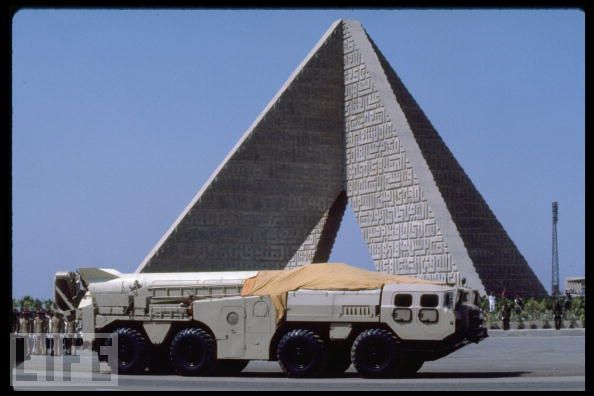اثيات دول عربية غير مصر تمتلك صواريخ نودنج

No Dong 1 displayed on TEL vehicle.
Jane’s Strategic Weapon Systems
The capabilities of the No Dong 1 missile are such that it can only
effectively be used against large, soft targets like cities, airports,
or harbors. Its range is sufficient to put parts of Japan within range.
The accuracy is extremely low for modern missiles and it is useless
against a hardened military target. The exact size of the payload is
unknown, but a medium yield nuclear warhead would maximize the potential
damage. It is mobile and easily concealable, making it difficult to
destroy prior to launch.
North Korea has provided little information about their ballistic
missile program. Much of the information about the No Dong missiles
stems from a comparison with the Ghauri missile of Pakistan and the
Shahab 3 of Iran, which all seem to be related missile programs. The No
Dong 1 missile has a range of approximately 1,300 km (807 miles). The
accuracy of the missile is believed to be 2,000 m CEP when deployed at
maximum range. Based on information obtained from its Iranian and
Pakistani sister missiles, it is believed to be 16.2 m in length, 1.36 m
in diameter, and a launch weight of 16,500 kg. It is equipped with a
1,200 kg separating warhead that can deploy 800 kg of HE-unitary,
chemical, submunitions, biological, or medium-yield nuclear weapons. It
can be launched from a converted Russian Transporter-Erector-Launcher
(TEL) vehicle design and from converted North Korean tanks and trucks.
The missile is presumed to use an inertial guidance system but may be
upgraded with a more accurate Global Positioning Satellite (GPS) system.
A nuclear warhead development program was started in 1990 which may
include warheads for the No Dong missiles. A North Korean statement in
2002 suggested that their scientists had assembled between 2 and 5
nuclear warheads; potentially, some of those were fitted to the No Dong 1
missiles.
It is believed that development of the No Dong 1 began in the
mid-1980s, with the first flight testing occurring in May 1990. The
missile is believed to have entered regular production in 1994 and
active service in 1995. Since 1994, North Korea has likely produced
hundreds of No Dong 1 missiles. US estimates have suggested that
production would be around 200 by 2006 while one South Korean report
suggested as many as 450 operational missiles by September 2006.
Some missiles may also have been produced for export. It is believed
that the No Dong 1 project was accomplished in conjunction with both
Iran and Pakistan. It is reported that Iran received 150 missiles,
although both North Korea and Iran deny the transaction. A comparison of
the Ghauri and the Shahab 3 indicates the missile technology developed
for the No Dong 1 was probably given or sold to Pakistan and Iran.
Certain components of the Ghauri and Shahab missiles may also have been
produced in North Korea. Other countries may also have been involved in
the project. Iraq, Eqypt, Syria, and Libya are all believed to have
negotiated to obtain the missile, though there are no known exports to
these countries.
1
- Lennox, Duncan. “No Dong 1/2.” Jane’s Strategic
Weapon Systems (Offensive Weapons). September 11, 2012. (accessed
September 12, 2012). ↩

وعن نفسي لا ارى ان الصواريخ البالستية مقصورة على دول فقط والاهم هو الراس التفجيري